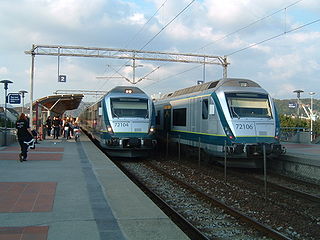Related Research Articles

Telenor ASA is a Norwegian majority state-owned multinational telecommunications company headquartered at Fornebu in Bærum, close to Oslo. It is one of the world's largest mobile telecommunications companies with operations worldwide, but focused in Scandinavia and Asia. It has extensive broadband and TV distribution operations in four Nordic countries, and a 10-year-old research and business line for machine-to-machine technology. Telenor owns networks in 8 countries.

The Jæren Line 74.7-kilometer (46.4 mi) long railway line between Stavanger and Egersund in Jæren, Norway. The name is no longer in official use and the section is regarded as the westernmost part of the Sørlandet Line. Owned by the Norwegian Railway Directorate, the line has double track from Stavanger Station to Sandnes Station, and single track from Sandnes to Egersund Station. The line is electrified at 15 kV 16.7 Hz AC and equipped with centralized traffic control and GSM-R. The line is served by the Jæren Commuter Rail and intercity trains along the Sørlandet Line, both operated by the Vy. CargoNet runs container freight trains on the line, which terminate at Ganddal Freight Terminal.

NMT is an automatic cellular phone system specified by Nordic telecommunications administrations (PTTs) and opened for service on 1 October 1981. NMT is based on analogue technology and two variants exist: NMT-450 and NMT-900. The numbers indicate the frequency bands used. NMT-900 was introduced in 1986 and carries more channels than the older NMT-450 network.
The signalling system used on the rail transport in Norway is regulated by the Regulations of December 4, 2001 no. 1336 about signals and signs on the state's railway network and connected private tracks.
GSM frequency bands or frequency ranges are the cellular frequencies designated by the ITU for the operation of GSM mobile phones and other mobile devices.

GSM-R, Global System for Mobile Communications – Railway or GSM-Railway is an international wireless communications standard for railway communication and applications.
1G refers to the first generation of wireless cellular technology. These are analog mobile telecommunications standards that were introduced in the 1980s and were superseded by 2G. The main difference between these two mobile cellular generations is that the audio transmissions of 1G networks were analog, while 2G networks were entirely digital.

NSB Class 72 is a class of 36 electric multiple units built by AnsaldoBreda for the Norwegian State Railways. Delivered between 2002 and 2005, the four-car units operate on the Oslo Commuter Rail and the Jæren Commuter Rail. The trains have a capacity of 310 passengers and the 2,250 kilowatts (3,020 hp) motors allow a maximum speed of 160 kilometres per hour (99 mph). The trains were ordered in 1997, with original delivery dates in 2001 and 2002. NSB also had an option to buy 40 additional units. The first units were not delivered until 2002, and by 2004, still half the trains were not in use. Faults included rust, too heavy train weight, and signaling problems. After the initial troubles, the Class 72 has been a highly successful train for NSB and well liked by the maintenance workers.

Hallingskeid Station is a train station on the Bergen Line in the municipality of Ulvik in Vestland county, Norway. Located at an elevation of 1,110 meters (3,640 ft) above mean sea level, the station is situated inside a snow tunnel. It opened along with the central section of the line on 10 June 1908 and remained as a staffed station until 1982. It is located on the Hardangervidda plateau in an area without population or road access. The station therefore serves trekkers and mountaineers. Only some of the Vy trains stop at the station.
The Åsta accident was a railway accident that occurred at 13:12:25 on 4 January 2000 at Åsta in Åmot, south of Rena in Østerdalen, Norway. A train from Trondheim collided with a local train from Hamar on the Røros Line, resulting in an explosive fire. 19 people were killed, while 67 survived the accident.

LKAB Malmtrafik, earlier Malmtrafik i Kiruna AB (MTAB), is a Swedish railway company which operates the iron ore freight trains on the Iron Ore Line and the Ofoten Line. MTAB is a wholly owned subsidiary of the mining company Luossavaara–Kiirunavaara (LKAB). In Norway, operations are handled by the subsidiary Malmtrafikk AS (MTAS). Malmtrafik hauls ore from LKAB's mines in Kiruna, Malmberget and Svappavaara to the ports of Luleå and Narvik, the latter located in Norway. The company owns 28 Iore locomotives and 750 hopper cars. Each train is 68 cars long and weighs 8,600 tonnes, allowing the company to transport 33 million tonnes per year.

The Radio Telephone Network C, was a first generation analog cellular phone system deployed and operated in Germany by DeTeMobil. It utilized the C-450 standard, originally developed by Siemens AG, and was the third and last update of a series of analog mobile phone systems used primarily within Germany, superseding the B-Netz and the A-Netz before it. It has been decommissioned, replaced by both the newer D-Netz and E-Netz systems, both based on GSM standards and operating on 900 MHz and 1800 MHz bands respectively.

Oslo Commuter Rail is a commuter rail centered in Oslo, Norway, connecting the capital to six counties in Eastern Norway. The system is operated by Vy and its subsidiary Vy Gjøvikbanen, using Class 69 and Class 72 electric multiple units (EMU). The network spans eight routes and 128 stations, with Oslo Central Station (Oslo S) as the central hub. The trains run on 553 kilometers (344 mi) of electrified mainline railway owned by the Bane NOR. Deficits are financed by the Norwegian Ministry of Transport, although the network also has a ticketing cooperation with Ruter, the public transport authority in Oslo and Akershus. The network is the longest commuter rail network in the Nordic countries, and among top ten in Europe.

Mobile Telecommunication Company of Iran, commonly abbreviated as MCI and also known under its brand name Hamrahe Avval, is the first and largest mobile operator in Iran. MCI is a subsidiary of the Telecommunication Company of Iran and has approximately 17 million postpaid and 49 million prepaid subscribers. Hamrahe Aval's service is available in 1,239 cities and over 70,000 kilometers of highway in Iran is sheet. It provides roaming services via 271 partner operators in more than 112 countries.
British Rail Telecommunications was created in 1992 by British Rail (BR). It was the largest private telecoms network in Britain, consisting of 17,000 route kilometres of fibre optic and copper cable which connected every major city and town in the country and provided links to continental Europe through the Channel Tunnel.

The Jæren Commuter Rail is a commuter train service operated along the westernmost part of the Sørland Line in Jæren, Norway. It is operated by Go-Ahead Norge with nine Class 72 electric multiple units. The service acts as a commuter rail connecting Stavanger to its suburbs, including Sandnes, and to towns further south, in Klepp, Time, Hå and Eigersund. Although passenger services have operated along the lines since 1878, the commuter train service was inaugurated in 1992 with a significant increase of service, using existing rolling stock. Ridership of the system increased from 3.2 million in 2012 to 5 million in 2019.
NSI-63 is a railway signaling system used for interlocking on the Norwegian railway network. It is based on relays and was developed by Norsk Signal Industri for the Norwegian State Railways (NSB) during the early 1960s. The systems are installed at railway stations and passing loops and consist of single relays built form drawings. The system is simple, robust and economical for smaller stations on single-track railways. The system makes use of track circuits for train detection.
The Norwegian Public Safety Network is a public safety network system based on Terrestrial Trunked Radio (TETRA). Nødnett is implemented by the Directorate for Emergency Communication. The network is primarily used for internal and interdisciplinary communication by the police, fire departments and health services. Nødnett is also used by several organisations participating in rescue and emergency work. Planning of the network started in 1995 and in 2006 the contract to build it was awarded to Nokia Siemens Networks. As Nokia Siemens Networks was unable to complete the contract, it was passed on to Motorola Solutions in 2012. The critical infrastructure of Nødnett was finished and was operational in all districts of mainland Norway by December 1, 2015.
The Norwegian railway network has used two types of train radio, Scanet and GSM-R. A train radio is a mobile telecommunications network that allows a train driver, maintenance crews and other rail transport officials to communicate with a dispatcher or each other. Scanet was an analog radio system installed on the main lines, limited to electrified lines with automatic train protection, between 1995 and 1999. The implementation left out many lines, which were instead covered by Nordic Mobile Telephone network.

Dr. Thomas Haug is an electrical engineer known for developing the cellular telephone networks.
References
- ↑ Solberg, Bjørn Olav (1994). "Train radio system for Norwegian State Railways" (PDF). Telektronikk. Telenor (4): 73–81. Archived from the original (PDF) on 18 July 2011. Retrieved 24 October 2010.
- ↑ Enghaug, Paul (11 February 2002). "NSBs nye togradio holder bare fem år". Aftenposten (in Norwegian). p. 11.
- ↑ Melsom, Jens (10 January 2002). "Kommentarer til høring– Fremtidig bruk at NMT-450 frekvensbåndene" (PDF) (in Norwegian). Norwegian Post and Telecommunications Authority. Archived from the original (PDF) on 24 July 2011. Retrieved 24 October 2010.
- 1 2 Savvas, Antony (19 November 2007). "Norwegian rail system migrates to mobile network to improve safety". Computer Weekly . Archived from the original on 13 November 2010. Retrieved 24 October 2010.
- ↑ "Høring – Endring av togframføringsforskriften og signalforskriften bl.a. som følge av innføring av GSM-R som togradio mv" (in Norwegian). Norwegian Railway Inspectorate. 6 July 2007. Archived from the original on 24 October 2010. Retrieved 24 October 2010.
- ↑ Nørbeck, Fredrik (2008). "GSM-R" (PDF). Lokomotivmands Tidende. National Union of Norwegian Locomotivemen (3): 14. Archived from the original (PDF) on 24 July 2011. Retrieved 24 October 2010.